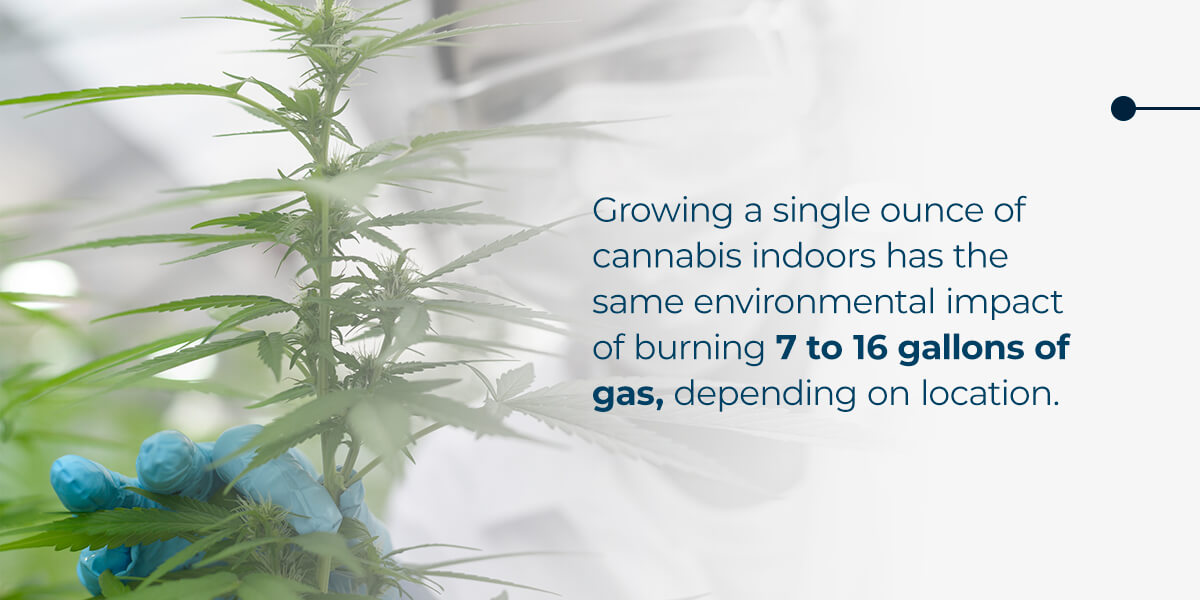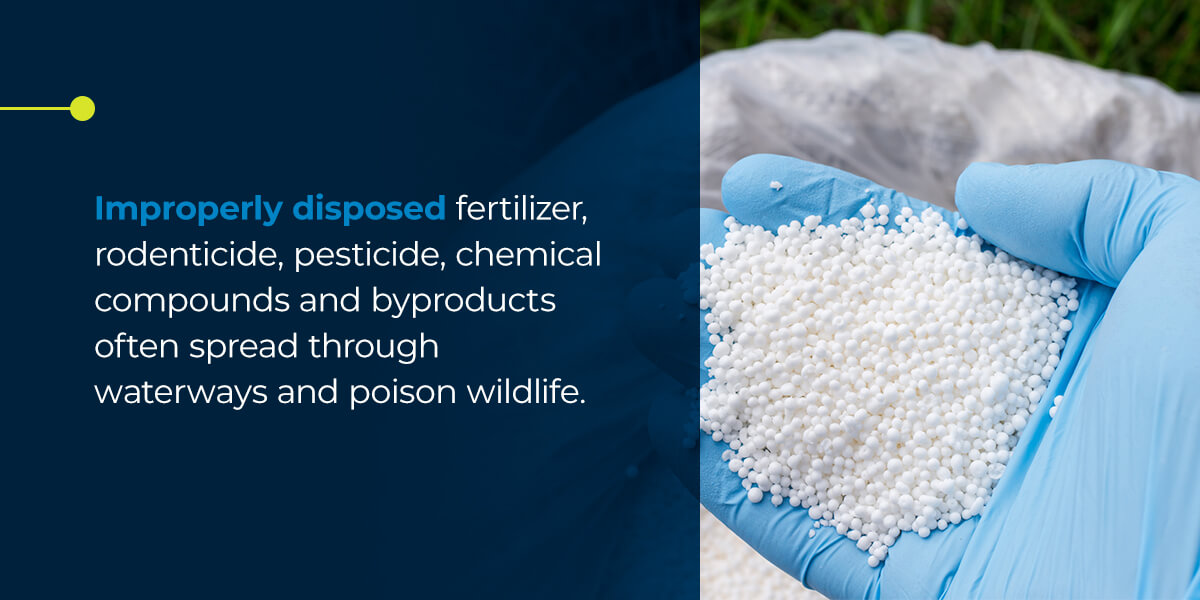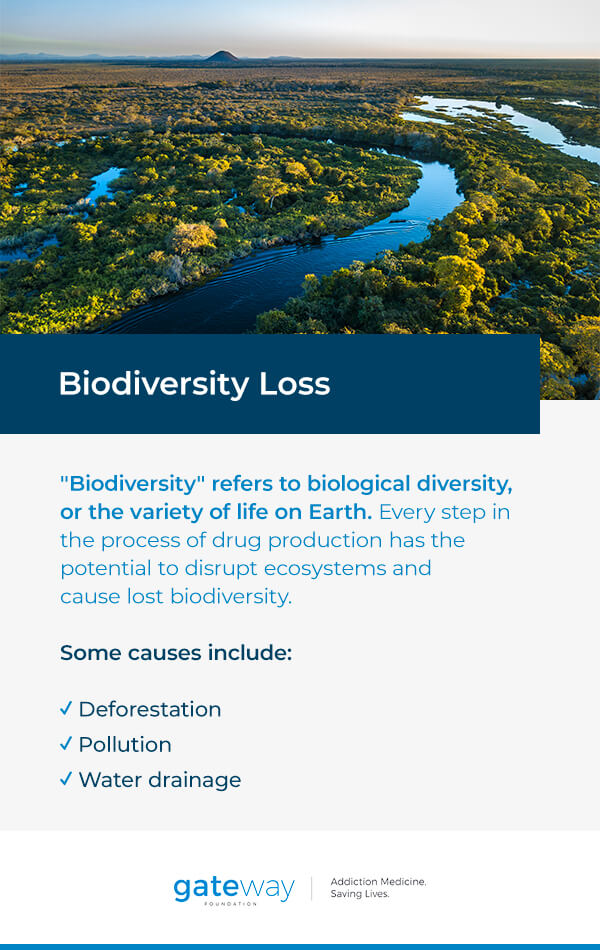- Dec 29
- AddictionDrug Addiction TreatmentRecovery
Are Drugs Bad for the Environment?
Addiction and environmental impact of drugs is an issue that is vital to address. The conversation about drugs almost always revolves around their impacts on societal wellness and personal health. It’s true that drug production and usage can cause widespread societal and public health concerns. But the effects of such substances have a more complicated bigger picture. Producing mass quantities of drugs harms the environment in multifaceted ways. It’s vital to address the environmental impact of producing drugs, whether or not those drugs are legal to use.
The increasing legalization of cannabis, including both recreational and medicinal cannabis crops, has drawn attention to some notable environmental issues in its production. When demand is high for such drugs, someone has to grow or produce them. Large-scale drug production operations have serious environmental implications — and they affect everyone.
- How Producing Drugs Affects the Environment
- Demand Drives the Market
- Contact Gateway Foundation for Addiction Recovery Services
How Producing Drugs Affects the Environment
Drug production leaves its mark on the environment in several ways. It results in large-scale carbon emissions, water depletion, pollution and biodiversity loss. Each of these effects has monumental short- and long-term implications for all life on Earth. It’s vital to acknowledge and understand the consequences. Keep in mind, legal and illegal drugs present different issues.
Legal vs. Illegal Drugs
The production of legal pharmaceutical drugs presents its own environmental concerns. The manufacture of legal drugs is a major source of pollution and carbon emissions worldwide. Since pharmaceutical drugs affect biological processes, related pollution can have complicated consequences. Pharmaceutical drug pollution can alter hormone levels in fish, for instance, degrading their ability to reproduce. It can also promote the development of drug-resistant bacteria, making them more dangerous. For these reasons, keeping pharmaceutical drugs contained is a priority scientists are only beginning to understand.
While manufacturing legal drugs can harm the environment, illicit drug production is a more complicated issue. Those who produce illegal drugs generally ignore laws and regulations intended to protect the environment. While new and existing regulations can have restorative impacts, environmental laws only make a difference for those who follow the rules.
Illegal drug producers often deplete resources, pollute ecosystems and cause other damage without any accountability. For that reason, it’s essential to recognize the environmental impacts of illegal drugs, specifically. Here are five of the most significant environmental effects of growing illicit drugs:
1. Carbon Emissions
Many resources are necessary for any drug’s production, some more so than others. The carbon footprint of cannabis production is an often-ignored side effect. With the drug becoming legal in more and more states, the carbon emissions it causes are crucial to acknowledge. Growing a single ounce of cannabis indoors has the same environmental impact of burning 7 to 16 gallons of gas, depending on location.
Indoor growth requires substantial electricity — the plants have complicated needs growers need to meet. They require powerful lights, temperature control, humidity control and other energy-consuming care. Wherever greater temperature control is necessary, greenhouse gas emissions are higher. For instance, drastic temperature increases are necessary for growing cannabis in Alaska or the Midwest. This heating drains energy, which may derive from burning fossil fuels. California’s warm climate means keeping cannabis plants thriving requires less energy. But, in this climate, water consumption is a greater concern than energy use.
Growing drugs outdoors also causes carbon emissions, resulting from deforestation, transportation and other processes. The exact carbon footprint of large-scale drug production is often difficult to measure. Estimates tend to be low since illicit drug growers try to remain undetected.
2. Water Usage
Water usage is another major environmental impact of cannabis cultivation. Cannabis crops require a lot of water — between 8-10 gallons per plant, per day, which is double as much as a grape or tomato plant needs. In 2012, over three billion gallons of water were used to cultivate cannabis in California alone. The number of cannabis crops has continued to increase since then, so even more water is necessary today.
In Northern California, water is an often scarce resource, and water demand for cannabis growth puts even more strain on local sources. Most cannabis farms in the region have inadequate water storage to last through the summer, meaning they have to rely on further extraction, often from wells. With droughts a common concern in California, water use for cannabis is a serious issue. In the long term, it could result in exacerbated water insecurity throughout the state.
3. Deforestation
Forest clearing for any agricultural purposes, drug or otherwise, is a major contributor to climate change. Deforestation causes carbon emissions, as each cut tree releases its stored reserves of carbon dioxide. Unregulated forest clearing for illicit substances is a major issue with long-term implications. In Colombia, the biggest cocaine-producing nation, coca growers clear remote sections of the nation’s rainforest to elude authorities. In only one year, carbon emissions from forest clearing for coca could be as much as two million tons.
Drug traffickers clear more than the forest space necessary for planting crops — they also carve out trees for transporting, storing and processing drugs. For instance, they often clear land for plane landing strips alongside their coca crops. Another concern is the land cleared for laundering purposes. Some drug traders create palm oil plantations to launder their illegal drug money, taking up even more once-forested land.
Effects of Deforestation
This mass deforestation has complicated effects on the environment beyond the initial carbon emissions it causes. Trees help regulate the water cycle — with the trees gone, reduced water in the air can result in dry soil. The dryness combined with increased erosion can create hostile, barren soil. In some cases, even crop growth becomes impossible. This impact could lead to food insecurity long-term, as less and less nutrient-rich soil is available.
Another effect of deforestation is habitat loss for all the species within, which often leads to species endangerment and extinction. Cutting down forests threatens entire ecosystems. Many forests are also home to Indigenous people, who rely on their natural resources for every aspect of life. They lose their homes to deforestation, as well, and must relocate or face labor exploitation in the drug-production process.
Forests play a major role in the Earth’s natural balances. Clearing forests for any purpose has serious environmental implications. While the vast majority of deforestation is for soya, meat and palm oil production, additional clearing for drug growth escalates the problem. And since forest clearing for illicit drugs is unregulated, strengthened laws would not fix the issue.
4. Toxic Waste Pollution
When it comes to illegal drug production, many growers fail to follow environmental regulations for disposing of waste. Improperly disposed fertilizer, rodenticide, pesticide, chemical compounds and byproducts often spread through waterways and poison wildlife. Toxic or hazardous waste pollution is a serious concern for aquatic ecosystems. For instance, prolonged exposure to cocaine can cause species decline for the European eel. Fish that engage in filter-feeding, such as Amazon basin catfish, are especially vulnerable to toxic pollution.
This issue is not contained to South America — the Netherlands and Belgium are hotspots for “party drugs.” Producing methylenedioxymethamphetamine (MDMA), for instance, requires hydrochloric acid and acetone. It results in hundreds of thousands of pounds of toxic waste every single year, often uncovered in remote areas and nature reserves. Sometimes, producers dump the waste in sewers or along roads. The improper disposal of these chemicals wreaks havoc on local wildlife.
Complying with hazardous waste disposal laws is a vital way to protect the environment, but those producing illicit substances do what they can to remain under the radar. The results are poisoned wildlife and destroyed ecosystems, which impact humans in complex ways.
How Does This Pollution Affect People?
Hazardous pollution related to illegal drugs, whether in the form of pesticides, herbicides, rodenticides or fertilizer, affects humans as well as plant and animal species. When toxic waste products enter the environment, they can impact humans’ food, air and water with long-term public health implications. And because illicit drug producers dump these chemicals secretly, communities may not be aware of their presence.
Exposure to one of these substances can cause complex health concerns. For instance, consuming pesticides, whether through contaminated water, air, plants or animal tissue, could result in:
- Increased risk of developing cancer
- A disrupted reproductive system
- Immune deficiency
- An impacted nervous system
- Malignant melanoma
Local populations are most likely to realize health issues from drug production and the pollution it causes. However, the consequences of unregulated pollution on humans are also indirect. Disrupting ecosystems in this way can cause large-scale chain reactions, diminishing the usable supply of necessary resources.
5. Biodiversity Loss
Another notable concern regarding illicit drug production is how it contributes to diminished biodiversity. “Biodiversity” refers to biological diversity, or the variety of life on Earth. Drug production diminishes biodiversity in multiple ways. Every step in the process of drug production has the potential to disrupt ecosystems and cause lost biodiversity. Some causes include:
- Deforestation: The most obvious culprit is deforestation. Clearing forests takes habitats away from plant and animal species. Destroying habitats in this way leaves species with nowhere to live and no food to eat, driving them toward extinction. Much of the deforestation for illicit drugs takes place in species-rich environments, like Colombia’s tropical forests. Some species in those forests exist nowhere else — once they’re gone, they’re lost for good.
- Pollution: In addition to deforestation, the pollution related to drug production can harm or kill species and disrupt ecosystems. Secretive dumping of pesticides and other chemicals, rather than proper disposal, is dangerous for any nearby species.
- Water drainage: The water use related to drug production can also cause lost habitat for aquatic species, especially in drought-prone areas like California. Pumping water from local sources may also change water temperatures, which can kill fish.
Why Does Biodiversity Loss Matter?
The rich variety of life on Earth makes the planet habitable for humans. Everything is connected — plants and animals rely on each other for their own survival. For instance, many animals rely on the calories in fruit while fruit-bearing plants rely on animals to spread and fertilize their seeds. As a result, animals that eat fruit keep plants alive, and those plants help regulate global carbon levels.
Such cross-species reliance is present in every one of Earth’s ecosystems. Biodiversity keeps everything balanced, and balance is as important to humans as any other species. Lost biodiversity means disruption, which contributes to climate change and other issues. It can even result in more devastating natural disasters — for example, living coral reefs protect coastal communities from waves and storms, so their destruction can render coasts less safe.
Humans also need biodiversity for health reasons. Studying plant and animal life, scientists discover new solutions to human health problems every year. As biodiversity disappears, so do cures for diseases before they’re ever known. The impact is greatest on communities that rely on traditional, plant-based medicine, which is about 60% of the world’s population.
Demand Drives the Market
Consumer demand for illegal drugs drives this global market and the environmental harm it causes. The popularity of common drugs like marijuana, cocaine and MDMA makes drug production lucrative. With illicit drug growth completely unregulated, growers do not comply with laws regarding pollution, waste management or resource use. Even regulated drug growth, such as that for legalized marijuana, has important environmental implications.
Whether legal or not, growing drugs requires land, water, hazardous chemicals and energy. Producers clear forests, drain water sources, release carbon into the atmosphere and pollute local environments with pesticides and other chemicals. It’s vital to consider how the demand for drugs impacts the Earth — and all the living things on it.
Every illicit drug user shares responsibility for the environmental impact of production. The reliable demand incentivizes drug growth and trafficking. Those who play a role in the illegal drug market should consider the long-term environmental effects they’re contributing to. In addition to its ecological impact, the illegal drug trade often relies on labor exploitation and violence — all things considered, playing a part in this market has complex ethical consequences.
Contact Gateway Foundation for Addiction Recovery Services
As you can see, illicit drug production causes serious environmental impacts in a multitude of ways. Its energy consumption results in carbon emissions, and related water usage strains aquatic ecosystems. Deforestation involved with drug production has many long-term effects, including degraded soil, disrupted water cycles and loss of natural habitat. When deforestation, pollution and other means destroy habitats, ecosystems suffer and biodiversity vanishes. The environmental consequences are complicated, and long-term implications are not always predictable.
Concern for the environment is one reason to stop using illegal drugs, but many other reasons are just as compelling. Those who struggle with substance use disorders understand the impact they can have on day-to-day life, including professional careers, mental health status and interpersonal relationships.
If you or someone you know is struggling with a substance use disorder, consider Gateway Foundation for recovery services. Here at Gateway Foundation, we offer expert care at varying levels of intensity, including both inpatient and outpatient services. Our care professionals will be with you for life, offering the help you need every step of the way. Reach out today to learn more about Gateway Foundation.






